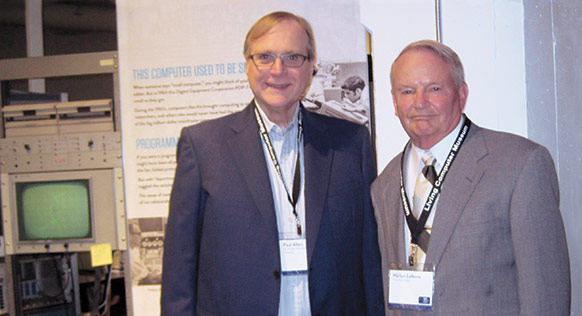
IRIS login | Reed College home Volume 92, No. 4: December 2013
Alumnus Profile
Scintillating Account

Harlan Lefevre ’51 (right) and Microsoft cofounder Paul Allen stand before the PDP-7 computer at a celebration for the Living Computer Museum in April 2013.
Harlan Lefevre ’51
Harlan Lefevre ’51, professor emeritus of physics at the University of Oregon, sent us a fascinating account of his career that began with the scintillation detector he built in 1951 for his thesis on low-energy X-Rays. After Reed, Harlan built dozens of scintillation detectors for use in nuclear physics—at Hanford, at the University of Wisconsin, at the University of Oregon, where he taught physics for 38 years, and at several laboratories in Australia and the U.S.
In 1964, Harlan and his associates at the University of Oregon built a four-MeV Van de Graaff accelerator for the Atomic Energy Commission. “In addition to the accelerator, we bought a high-voltage terminal with a duo-plasmatron ion source and a klystron buncher for neutron time-of-flight spectrometry,” he reports. “Our system was almost unique in the world at the time.” Soon after, Harlan’s team won a grant from the National Science Foundation to buy a DEC PDP-7 computer for the accelerator. “The PDP-7 arrived in 1966,” he says. “For the next 30 years it was a vital part of our laboratory. Some 30 graduate students used it in their doctoral work. Some 60,000 hours of use were recorded.”
In 2006, Harlan suggested that the PDP-7 join the Living Computer Museum in Seattle, where it now enjoys a front-and-center position, along with a scintillation detector he assembled. “The scintillation counter I added at the museum allows the PDP-7 to collect gamma-ray spectra from radioactive sources and display the spectra using software we developed and used for many years,” says Harlan. “And it’s still running.”

LATEST COMMENTS
steve-jobs-1976 I knew Steve Jobs when he was on the second floor of Quincy. (Fall...
Utnapishtim - 2 weeks ago
Prof. Mason Drukman [political science 1964–70] This is gold, pure gold. God bless, Prof. Drukman.
puredog - 1 month ago
virginia-davis-1965 Such a good friend & compatriot in the day of Satyricon...
czarchasm - 4 months ago
John Peara Baba 1990 John died of a broken heart from losing his mom and then his...
kodachrome - 7 months ago
Carol Sawyer 1962 Who wrote this obit? I'm writing something about Carol Sawyer...
MsLaurie Pepper - 8 months ago
William W. Wissman MAT 1969 ...and THREE sisters. Sabra, the oldest, Mary, the middle, and...
riclf - 10 months ago